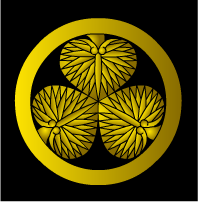
Kii Province, or Kishū (紀州), was a province of Japan in the part of Honshū that is today Wakayama Prefecture, as well as the southern part of Mie Prefecture. Kii bordered Ise, Izumi, Kawachi, Shima, and Yamato Provinces. The Kii Peninsula takes its name from this province.

The Kii Peninsula is the largest peninsula on the island of Honshū in Japan. It is named after the ancient Kii Province.

Hirado Castle was the seat of the Matsura clan, the daimyō of Hirado Domain, of Hizen Province, Kyūshū. It is located in present-day Hirado city Nagasaki Prefecture, Japan. It was also known as Kameoka Castle.
The Wakayamakō Line is a railway line operated by Japanese private railway company Nankai Electric Railway that runs in Wakayama, Wakayama Prefecture, between Wakayamashi and Wakayamakō stations.

Echizen is a city located in Fukui Prefecture, Japan. As of 1 July 2018, the city had an estimated population of 83,078 in 20.341 households and the population density of 360 persons per km². The total area of the city was 230.70 square kilometres (89.07 sq mi). The modern city of Echizen was established on October 1, 2005, from the merger of the city of Takefu and the town of Imadate ; although the Echizen Basin has been an important regional center for over 1,500 years. The city is home to the largest number of cultural assets in Fukui Prefecture and has many former castle sites and prehistoric archeological sites.

The Tokugawa Gosanke, also called simply Gosanke, or even Sanke, were the most noble three branches of the Tokugawa clan of Japan: Owari House of Tokugawa, Kii House of Tokugawa, and Mito House of Tokugawa, all of which were descended from clan founder Tokugawa Ieyasu's three youngest sons, Yoshinao, Yorinobu, and Yorifusa, and were allowed to provide a shōgun in case of need. In the Edo period the term gosanke could also refer to various other combinations of Tokugawa houses, including (1) the shogunal, Owari and Kii houses and (2) the Owari, Kii, and Suruga houses.

Wakayama Station is a railway station in Wakayama, Wakayama Prefecture, Japan, jointly operated by the West Japan Railway Company and the Wakayama Electric Railway.

Matsue is the capital city of Shimane Prefecture, Japan, located in the Chūgoku region of Honshu.

Tsuyama Domain was a Japanese domain of the Edo period. It was associated with Mimasaka Province in modern-day Okayama Prefecture.

The Kishū Domain, also known as Kii Domain (紀伊藩) or Wakayama Domain (和歌山藩), was a han or Japanese feudal domain in Kii Province. The domain spanned areas of present-day Wakayama and southern Mie prefectures, and had an income of 555,000 koku. The domain was administered from Wakayama Castle in present-day Wakayama, Wakayama Prefecture. The heads of the domain were drawn from the Kishu-Tokugawa clan, one of the Gosanke, or three branches of the Tokugawa clan. The domain was founded by Tokugawa Yorinobu, the tenth son of the shōgun Tokugawa Ieyasu, when he moved from Sunpu Domain in Suruga Province to Kii Province. The Kishū came to control the smaller adjacent Tanabe and Shingū domains. The Kishū Domain was noted for its production of the Kishū mikan, soy sauce, lacquerware, and high-grade oak charcoal during the Edo period, and leather and cotton production by the Meiji Restoration in 1868.

Matsusaka Castle was a Japanese castle located in Matsusaka, Mie Prefecture, Japan. Throughout most of the Edo period, Matsusaka Castle was a secondary administrative center for the Kishu-Tokugawa clan, daimyō of Kishū Domain. The site has been proclaimed a National Historic Site by the Japanese government.

Wakayamashi Station is a railway station in Wakayama, Wakayama Prefecture, Japan. To distinguish it from Wakayama Station, the station is called "City Station".

Wakayamakō Station is a railway station in Wakayama, Wakayama Prefecture, Japan, operated by the private railway operator Nankai Electric Railway.
Wakayama 3rd district is a constituency of the House of Representatives in the Diet of Japan. It is located in Wakayama Prefecture and consists of Arida, Gobo, Shingu, and Tanabe cities and the Arida, Hidaka, Higashimuro, and Nishimuro districts. As of 2012, 298,296 eligible voters were registered in the district.

Wakayamadaigakumae Station is a train station on the Nankai Main Line in the city of Wakayama, Wakayama Prefecture, Japan, operated by the private railway operator Nankai Electric Railway. It serves Wakayama University.

Wakayama Prefectural Museum is a museum in Wakayama, Japan. It is one of Japan's many museums which are supported by a prefecture.

Mount Izumi Katsuragi is a mountain in the Kongō Range straddling the border between Osaka and Wakayama Prefectures in Japan. Its peak elevation is 858 metres (2,815 ft).


































